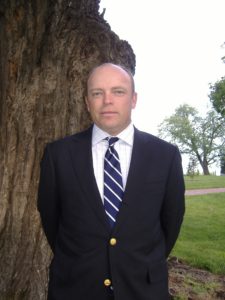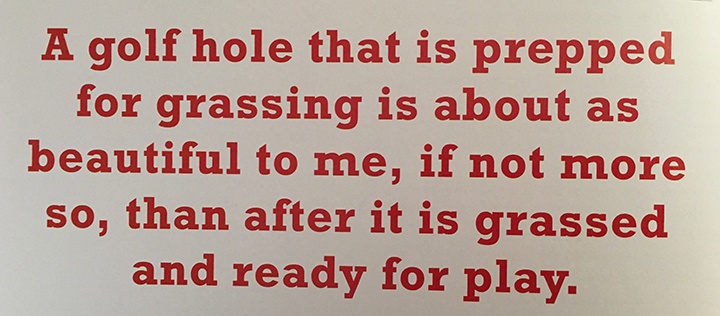Norman, Oklahoma-based Tripp Davis approaches golf architecture from the perspective of a player. He was an NCAA All-America selection while at the University of Oklahoma and is currently ranked as one of the top amateur golfers in the country. He plays a limited number of national amateur events each year. His Texas courses include the Tribute Golf Club in The Colony and Raven Nest Golf Club in Huntsville. He also designed Grand Elk Ranch and Club in Granby, Colorado; Coldwater Golf Links in Ames, Iowa; and Cherokee Hills Golf Club in Catoosa, Oklahoma.
 While I wish I could say I get up at around 5 a.m. every Monday morning to head to the gym for a workout, it probably happens only a few times a month. I try to stay in shape because the travel schedule and long work hours are both a mental and physical challenge.
While I wish I could say I get up at around 5 a.m. every Monday morning to head to the gym for a workout, it probably happens only a few times a month. I try to stay in shape because the travel schedule and long work hours are both a mental and physical challenge.
On most mornings I will set up my large light table with the drawings I need to work on that day. I have a four-foot by eight-foot light table that I love working on because I can get almost any size drawing on it and I can usually set up two or three different drawings for the day.
Depending on everyone else’s schedule at Tripp Davis and Associates Golf Architecture that day, including Gary Brawley who works out of Peoria, Arizona, we try to get together around 10 to 10:30 for a Monday conference call to discuss each project, everyone’s schedule, and objectives for the week.
Deciding on where to go to lunch, with all of the great restaurants in Norman, can be the toughest decision of the day. On most days, we all go together and everyone tries to leave their cell phones at the office. We rarely talk about work at lunch.
Right after lunch almost always seems to be my most productive drawing time. I am a big believer that anyone can get more done, and do their work at higher level, if they are focused on specifically what they are working on for relatively short chunks of time. If I try to spend more than an hour and a half to two hours on one single thing, it becomes hard to stay extremely focused.
After a short break, I will start drawing again at around 3 p.m., work for another hour and a half, and then get with Hattie, my assistant, to see what she has been working on, review her work, and go over what she needs to be focused on if I am going to be out of town for the next two or three days. By 5 p.m. I will get back to drawing, or attend to paperwork until I usually head for home around 6:30.
Now, let me be clear that this is an ideal day, that does not include conference calls, putting out fires (they do happen), meeting a deadline, meeting a request (such as getting info to a client, consultant, or builder who has an immediate need in order to keep their work moving), and more. While there are a lot of things that can inhibit a typical day, it is vital to stay disciplined on two things – remaining focused, without interruption, on a task for at least forty-five minutes, and switching gears (attending to email, phone calls or something else) at least once every two hours.
For a travel day or a day on site, it is typical for me to get up around 5 a.m. Once I get to a site, I like to spend a few minutes with the builder’s project superintendent to see how things are going. With almost every visit there are also meetings I have with the client or a client representative, or on occasion one of the engineers or planners.
I get the greatest satisfaction from seeing things being built and making those minor adjustments which will make the work that much better. I anticipate the opportunity to get out on the course the whole time I am on the way to a project, and I like to get out there as soon as possible.
I have the most fun working on features to make sure they work visually. I am a firm believer that what the player sees is most important. Even a subtle shift of a tee ten feet left or right, or the raising of a bunker lip just one foot, can have a dramatic impact on the feel the player has. I use the ability to create a certain feel to a shot as much or more than the plan view layout of features in the development of strategy. It is one of the ways in which I can make a hole look more challenging, especially to the better player, than it really should play – an important tool in making a golf course strategically interesting, yet not overly difficult physically for the average player.
I actually like the time during construction right before we are ready to grass. A golf hole that is prepped for grassing is about as beautiful to me, if not more so, than after it is grassed and ready for play.
I will try to spend at least a day and a half on each job site – or more if I might be gone for a couple of weeks before getting back. I really prefer be around as things are built rather than coming in merely to comment on design and provide direction for something I hope to look at during my next visit. Being on site as things are built is more fun, it engages the guys on the job to work harder, and we can get more done and move on. I like to try and get a few of the guys on site together for dinner.
The day to day of being a golf course architect is not often as glamorous as it might seem to be, but at the end of the day, after a plan you worked hard to develop comes to life in the dirt, it is satisfying.

